Act I
Need a Kidney: Scene 1
Cam and Jordan are living their best lives, except for one thing: Cam needs a kidney, and Jordan is determined to help him get one. Their plan:
- Find a kidney. Maybe there’s someone out there who needs $ more than they need a kidney.
- Do an Internet search to find a kidney broker, someone who can help find a kidney.
- Oh, looky! Here’s a consultant who shows up at the top of the Google search! (We don’t even wanna know how much money it cost to get there!)
- Hire a kidney consultant to help broker us a kidney.
- The kidney might be in another locale that is more friendly about this type of thing. Some locales have more rules about this than others. We wouldn’t want the kidney holder to back out once the agreement is made. We need a kidney-friendly locale with laws that are on our side, and the consultant can help us with that.
- Get that kidney installed in Cam and live happily ever after.

Need a Kidney: Scene 2
Cam and Jordan are living their best lives, except for one thing. Cam needs a kidney, and Jordan is determined to help him get one. Their plan:
- Educate themselves on what factors make someone want to donate a kidney, as well as what the lifelong effects might be for them.
- Ask their doctor about national protocol and standards for kidney donation.
- Understand the procedures in place to maintain ethics in such a high stakes and highly emotionally charged situation.
- Go through proper channels to protect the integrity of such a high stakes and highly emotionally-charged situation. Uniform rules make clear what is and isn’t ethical.
- Maintain a clear conscience.
- Find a possible donor, treat them respectfully now and ever after.
- Acknowledge the magnitude of the donor’s decision.
- Be eternally grateful for the extended chance at life.
When Stakes are High
Clearly our heroes are in a dire situation. You can’t blame Scene 1’s Cam and Jordan for wanting to get Cam a kidney by any means possible.
The problem is with what means are possible.
Why do we have standards and protocols about kidney donation? Because some means to the end simply are not acceptable in a civilized society.
Advances in medicine made living donor kidney transplants possible in the mid-20th century. It later became clear that there are certain practices that should be out-of-bounds when matching kidney donors with kidney recipients. So in 1984 we put in place standards and protocols to prevent organ harvesting, coercion, and the undue influence of money. Of course we would have standards and protocols, and of course they would be the same throughout the land — not a patchwork of state-by-state laws.
Intermission
Let’s now consider another scenario, one that also involves humans meeting the needs of other humans at great cost to themselves, also with ample desperation and heightened emotions.
Act II
Want a Baby: Scene 1
Cam and Jordan are living their best lives, except for one thing. Cam and Jordan cannot conceive and deliver a baby. They are determined to adopt one. Their plan for infant adoption:
- Find a newborn. Maybe there’s someone out there who needs $ more than they need a baby.
- Do an Internet search to find someone who can help find a baby.
- Oh, looky! Right at the top of the Google search is someone who can find us a baby! (We don’t even wanna know how much money it cost to get there.) Is it an agency? A facilitator? Hard to tell. And who cares?
- Hire that top-of-search entity to broker us a baby.
- The birth mother might be in another state that is more friendly about this type of thing. Some states have more rules about this than others. We wouldn’t want the birth mother to back out once the agreement is made. We need a state with laws on our side, and our broker can help us with that.
- Get the woman to give us her baby and then live happily ever after.
~~~~~
Don’t you wonder why we have standards and protocols in place for transferring body parts from one person to another but we do not have the same precautions for transferring entire humans from one person to another? Consider these two major differences in oversight:
1. In private adoption, there is scant national standardization of protocols.
Because many laws about adoption exist at the state level, we end up with “adoption-friendly states.” These are known as places that have laws benefiting adopting parents.✶
Further, the existence of patchwork state-by-state laws allows for Byzantine human trafficking schemes, in which a bad actor can move vulnerable pregnant women around the country to various adoption-friendly states to facilitate gray-market adoptions and make a lot of money in the process, like the Paul Peterson horror in recent years. Even though he pleaded guilty and is behind bars for a few years, you can bet such baby brokering is still happening, most easily in “adoption-friendly states.”
✶And, by extension, also benefiting adoption professionals, who get paid by them. The infant adoption industry was worth an estimated $1.16 billion (!) per year in 2015, with most of the professionals above-board players — but not all.
2. There are unlicensed entities brokering adoptions that have no accreditation…
… are not required to adhere to any code of ethics, and are not accountable to anyone except for the desperate parties they serve. There is no requirement to provide education for the clients they match together about the lifelong impacts of adoption. And if you think that’s no big deal, consider if it’s wise to go into something as life-changing as adopting a child or placing a child and not having any quality education about it.
But perhaps most concerning is that often huge sums of money are involved. These brokers, which often try to look like a licensed agency but are not, spend up to $80,000 per month to get to the top of an Internet search, according to Kelsey Vander Vliet Ranyard, Director of Advocacy & Policy at AdoptMatch.
Pity the pregnant woman who Googles “put my baby up for adoption” and lands in unlicensed/unaccountable hands. Pity the infertile couple who Googles “adopt a baby” and lands in unlicensed/unaccountable hands. Licensed-and-ethical† agencies don’t have the funds to make such investments in Search Engine Optimization because they’re spending their lower fees instead on serving their clients.
Some states allow for unlicensed adoption professionals and some states don’t. See previous point about lack of standardized policy.
† Licensed and ethical don’t always go together. But choosing a licensed professional does offer more recourse in the case of a breach of ethics than does choosing an unlicensed entity.
We’ve Always Done Adoption This Way. Why Change?
Unlike with organ donation, which had a defined start date when technology allowed for such a procedure to take place, adoption had no moment when we intentionally decided what an ethical process looks like. Instead, we have muddled our way through Orphan Trains, Black Market Baby Broker Georgia Tann, and the Baby Scoop Era as we gradually enacted (or didn’t) a hodge-podge of state laws, many of them stemming from and perpetuating shame and secrecy rather than truth and transparency.
Secrecy and the ability to operate without accountability are ingredients bad actors need to operate.
Let’s get this out of the way. Obviously, not all — not even most adoption professionals — are bad actors. If you’re reading this and you’re not one, I’m clearly not calling you out. But I am calling out entities that prey on vulnerable women in an unplanned pregnancy and on people desperate to become parents. I am calling on all who care about the ethical treatment of placing parents, adopting parents, and babies at the center of it all, to help reform adoption policies and practices.
Begin to wonder: why don’t we have such standards and protocols also in place for adopting a baby or a child? And start to imagine what adoption should look like if it had similar guardrails to organ donation protections. Then let’s work to put these standardized guardrails in place.
Which brings us to Act III. Here’s what modern adoption should look like, could look like, if we decide to treat babies at least as well as we treat kidneys — and, by extension, if we decide to treat expectant and birth parents with at least as much respect and concern as we treat organ donors.
Act II
Want a Baby: Scene 2
Cam and Jordan are living their best lives, except for one thing. Cam and Jordan cannot conceive and deliver a baby. They are determined to adopt one. Their plan for infant adoption:
- Educate ourselves on the factors that make someone need to place a baby for adoption, as well as what the lifelong effects might be for them and for the child.
- Ask about national protocol and standards for ethical adoptions.
- 2021: Wonder why one state’s rules are different from others’
- 202X: Find protocols online because Congress passed a bill standardizing key ethical components of domestic infant adoption across all states.
- Go through proper channels to protect the integrity of such a high stakes and highly emotionally-charged situation.
- Resist the siren song of unlicensed operators whose ads come up in an Internet search because they paid lots of money to be there. Choose instead to go through less predatory channels, namely a licensed professional who has a reputation for finding homes for babies rather than for finding babies for homes.
- Treat the other mother of your child respectfully now and forever. Also recognize the dignity and importance of the birth father, for his sake as well as for the sake of your child.
- Maintain a clear conscience by treating everyone else in accordance with the Golden Rule.
- Be eternally grateful for the opportunity to be a parent.
Join Us
Check out this brilliant post by my friend Rebecca Vahle. Because she has created the nation’s only hospital-based education program that addresses adoption (standardized! with accountability! with education!), she has a unique take on the issue.
Change needs to happen. We must be more humane about infant adoption, the way we came to be with living organ donation. If you’d like to be a part of this change, sign up on this simple google form so we can include you in upcoming efforts to legislate protocols and standardize laws in all states. At that time we’ll need you to raise your voice with us, a small but mighty group of people who are determined to make this right in our lifetimes.
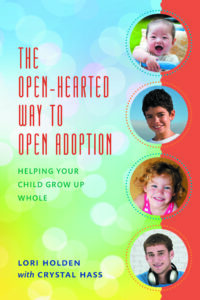
Lori Holden, mom of a young adult daughter and a young adult son, writes from Denver. She was honored as an Angel in Adoption® by the Congressional Coalition on Adoption Institute.
Her first book, The Open-Hearted Way to Open Adoption: Helping Your Child Grow Up Whole, makes a thoughtful anytime gift for the adoptive families in your life. Her second book, Standing Room Only: How to Be THAT Yoga Teacher is now available in paperback, and her third book, Adoption Unfiltered, is now available through your favorite bookseller!
Find Lori’s books on her Amazon Author page and catch episodes of Adoption: The Long View wherever you get your podcasts.


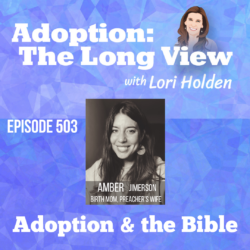
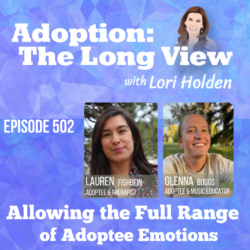
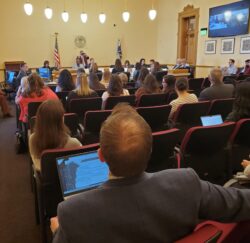
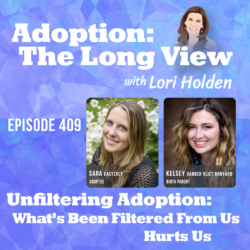

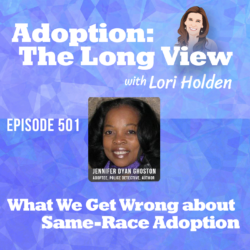

One Response
It is always interesting seeing the differences between adoption in the US and in NZ, where it is very much government controlled, avoiding the pitfalls of unlicensed, unregulated, unethical operators in the field. You’ve opened my eyes once again.